#avengers 1959
Explore tagged Tumblr posts
Text

My acquisition of Dum Dum Dugan by Mike McKone
#Mike McKone#art purchase#purchased art#Dum Dum Dugan#Howling Commandos#S.H.I.E.L.D.#World War II#WWII#Avengers 1959#US Army#Rangers#British Army#Godzilla Squad#S.T.A.K.E.#C.R.A.D.L.E.#Marvel Comics#Marvel Comics art#comic art#comic book art#comics#comic books#war comics#battle comics#military comics#art#artwork#illustration#S.H.I.E.L.D. art#Howling Commandos art
5 notes
·
View notes
Text

Avengers 1959 #3 - January 2012, cover by Howard Chaykin.
1 note
·
View note
Text
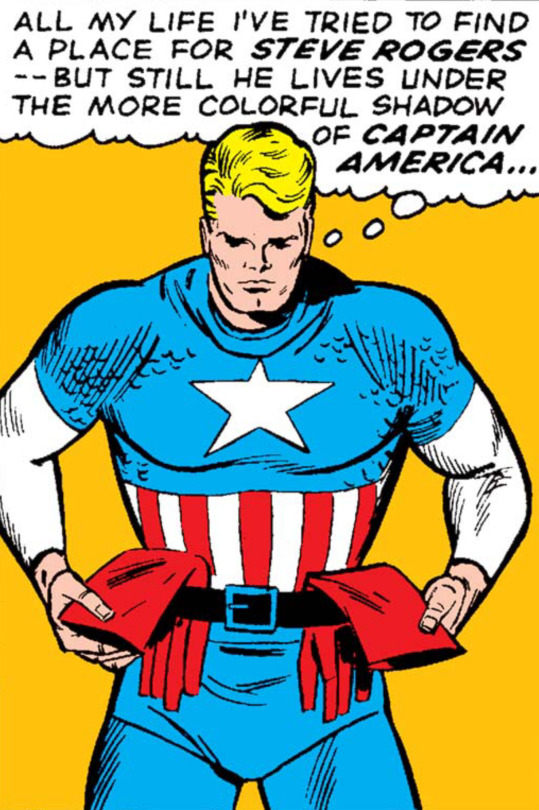

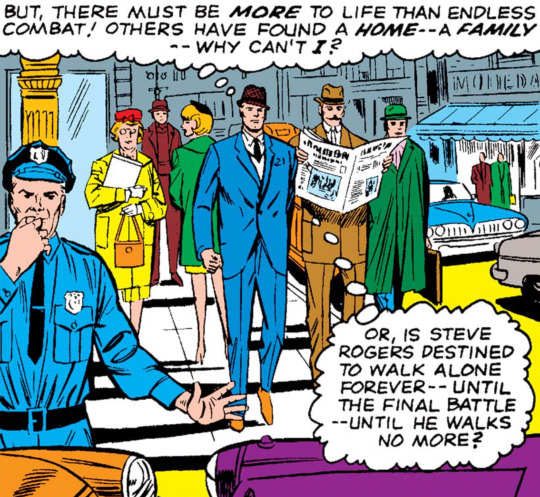
Steve Rogers
Tales of Suspense (1959) #75
#marvel#avengers#marveledit#comicedit#steverogersedit#captainamericaedit#steve rogers#captain america#tales of suspense (1959)#616#stan lee#jack kirby#dick ayers#marvel comics#avengerscompoundedit
119 notes
·
View notes
Text
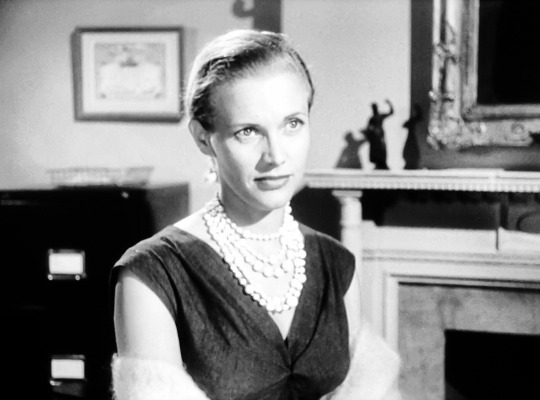


Honor Blackman guest stars as art expert Syd Lewis in Saber of London: Deep in the Heart of Chelsea (1.3, NBC, 1957)
#fave spotting#honor blackman#cathy gale#saber of london#the vise#the avengers#classic tv#deep in the heart of chelsea#1957#nbc#so im visiting parents for a week or two and taking the opportunity to catch up on my old tv watching as i have access to my beloved#dvd collection. Saber was one of the final network releases I've located (after‚ i might say‚ a long long search for a reasonably priced#copy). so. the story of Saber of London. (deep breath). SoL is really a development of The Vise; for more on the needlessly complex history#of that series you can follow the appropriate tag above. in short The Vise was a crime anthology made specifically for US tv but produced#in the UK using brit actors writers and directors. the recurring character of Mark Saber was popular enough that the show eventually became#The Vise: Mark Saber; it then became Saber of London. some sources still regard this show as essentially being a later series of The Vise#(and it does still use the og theme tune over the end credits) but considering the title change and (crucially) the fact that SoL saw the#series move from ABC to NBC‚ im gonna consider this its own self contained show and number the episodes accordingly (ie. this is series 1 o#Saber of London not series 5 or 7 (depending on your counting) of The Vise). anyway now that's all out of the way.#there's little material difference between this series and the slightly earlier The Vise: Mark Saber episodes besides new titles and a#different introductory spiel from star Donald Gray. our hero is still a plucky private detective undertaking modest cases that the show's#budget will allow. this ep concerns art forgeries and an attempt to trap the criminals responsible‚ which means Saber must call on an art#expert to help authenticate the works. enter Honor! not yet a star‚ Honor did have a decade of acting experience behind her#which is maybe reflected in the fact that she's given an unusually meaty part for a woman in this series: she's neither victim nor love#interest (which are the usual roles) but a witty and intelligent source of assistance to the hero.#unlike The Vise episodes (which could take up to a decade to appear in the uk if they did at all) SoL appears to have had a fairly regular#slot from Granada about two years after the show's US premier. this ep would have been seen by uk audiences in 1959
10 notes
·
View notes
Text
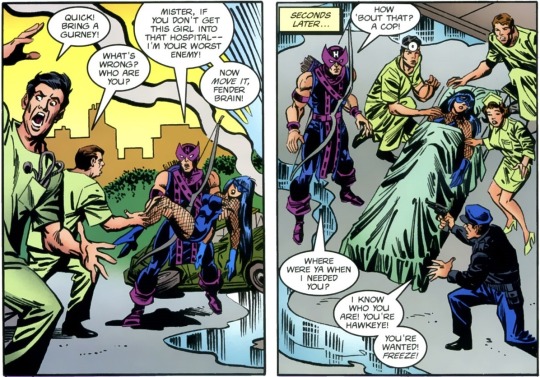
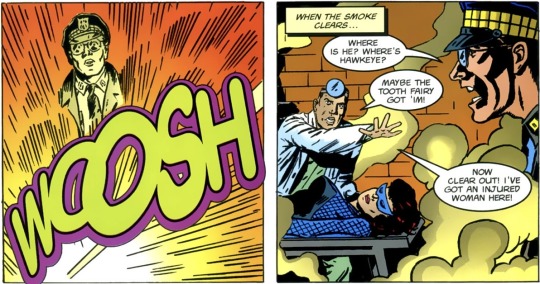
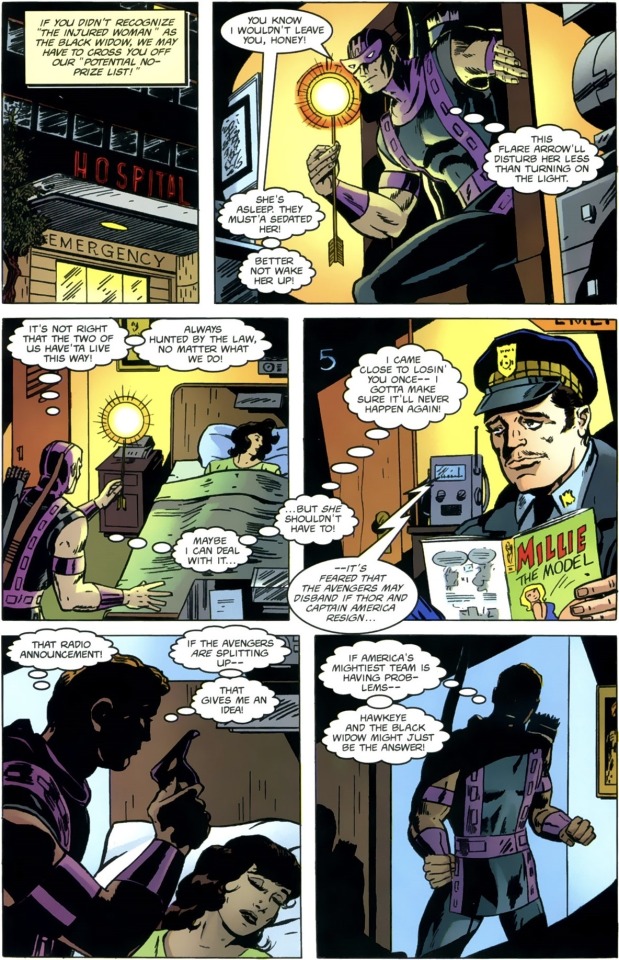
Marvel: Heroes & Legends (1997) #1
#I think this is actually a great way to bridge the gap of the differences between their appearances in#the Iron Man story in Tales of Suspense (1959) issue 64 and The Avengers (1963) issue 16#marvel#clint barton#natasha romanoff#my posts#comic panels
4 notes
·
View notes
Text
i'm back on my "mcu steve was in the darkest timeline because he never experienced the canon event of tony stark giving him a home and a family" bullshit. post-ice steve was isolated, grieving, lonely, going through ptsd and survivor's guilt and he was constantly fixated on how he had no home or family or identity beyond cap. post-ice in the mcu, SHIELD stuck him in the costume and sent him back into the field, reinforcing the idea that he was nothing more than the empty shell of captain america.
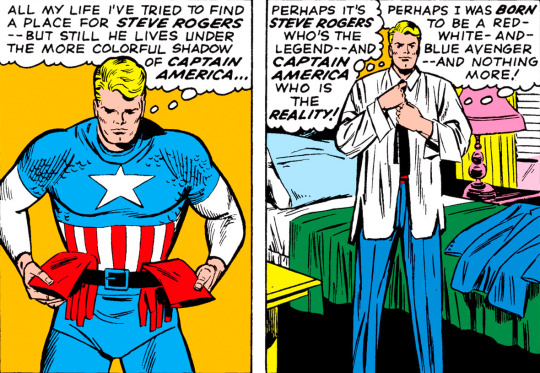

"All my life I've tried to find a place for Steve Rogers—but still he lives under the more colorful shadow of Captain America… Perhaps it's Steve Rogers who's the legend—and Captain America who is the reality! Perhaps I was born to be a red-white-and-blue Avenger—and nothing more! But there must be more to life than endless combat! Others have found a home—a family—why can't I? Or, is Steve Rogers destined to walk alone forever—until the final battle—until he walks no more?"
— Tales of Suspense Vol. 1 #75 (1959)
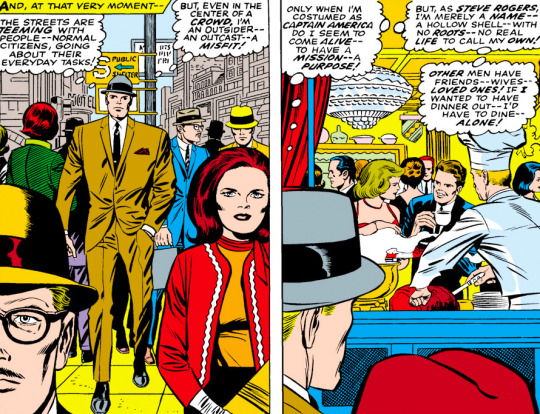
"[...] But, even in the center of a crowd, I'm an outsider—a misfit! Only when I'm costumed as Captain America do I seem to come alive—to have a mission—a purpose! But, as Steve Rogers, I'm merely a name—a hollow shell—with no roots—no real life to call my own! Other men have friends—wives—loved ones!"
— Tales of Suspense Vol. 1 #92 (1959)
in the comics, the canon event of tony stark, the first person steve meets in the 21st century, giving him all of those things — a purpose, a home, somewhere to belong as himself and not just cap — changed his entire life.
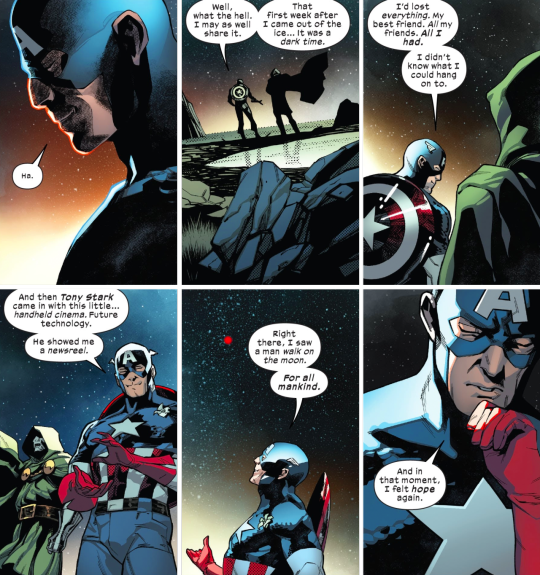
"The first week after I came out of the ice… It was a dark time. I'd lost everything. My best friend. All my friends. All I had. I didn't know what I could hang on to. And then Tony Stark came in with this little… handheld cinema. Future technology. He showed me a newsreel. Right there, I saw a man walk on the moon. For all mankind. And in that moment, I felt hope again."
— S.W.O.R.D. Vol. 2 #6 (2021)
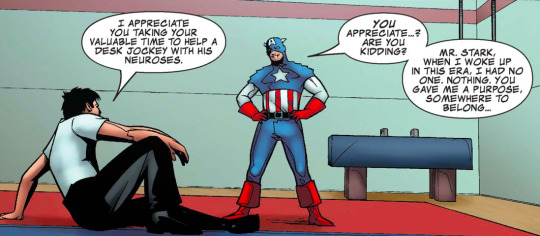
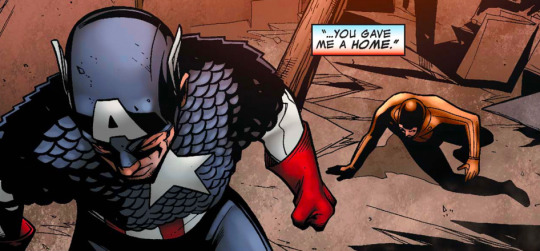
"Mr. Stark, when I woke up in this era, I had no one. Nothing. You gave me a purpose. Somewhere to belong… You gave me a home."
— Iron Man/Captain America: Casualties of War (2006)
meeting tony and the avengers, creating those friendships and connections, living at the avengers mansion with them, gives steve hope that he can still find happiness and belonging in the present day.
i always found it ironic that in the mcu steve projects this ideal of happiness and domestic life onto tony. this scene in ca:cw is a perfect example of that disconnect between the reality and what steve assumed on the surface was tony achieving what he never could — having a partner, his own family and kids. (the fact that cacw tony is 4 seconds away from a heart attack at all times and too busy running around firefighting PR crises just further drives home the irony.)

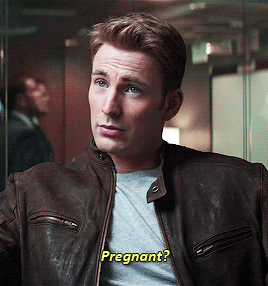
and then in a cruel twist of fate, mcu actually gives tony all of these things: home, family, wife and kid. we see steve witnessing tony having these things and knowing it's all possible, but just not for him and not in this era. (and ultimately, tony only gets to have these things for a brief period of time before having to give it all up.)
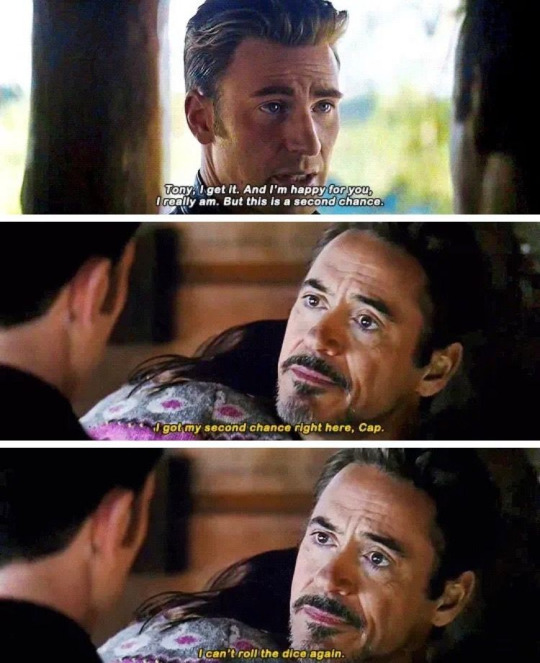
mcu steve never got to have the experiences that have shaped every other universe's steve rogers. the presence of tony stark, his friendship, his home, his love (whether platonic or romatnic), that formed the foundation of steve's purpose within the avengers, is intrinsic to steve finding hope and happiness in the modern day. the mcu changing such a crucial canon event rewrote not only the core of mcu steve's story but the trajectory of the cinematic universe. and in the end, the writers sent steve back to the past because they believed after 6 movies and 7 years, he had nothing left to live for in the present and i honestly can't think of anything more tragic.
1K notes
·
View notes
Text
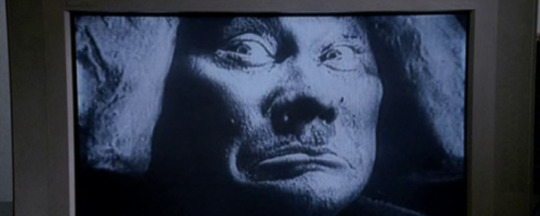
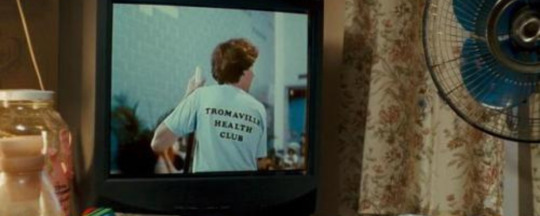
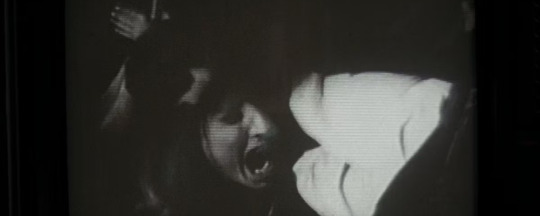



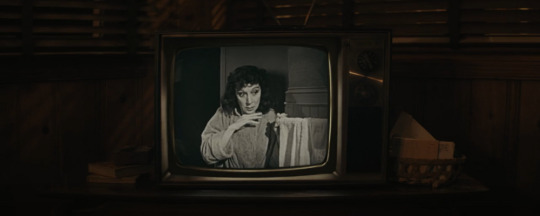


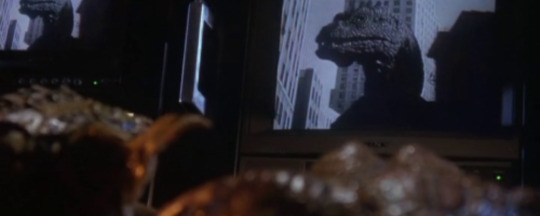

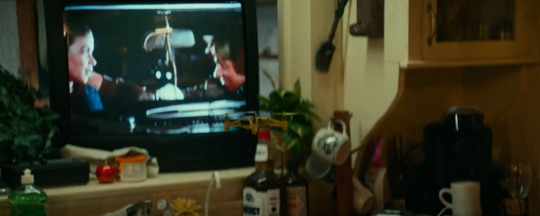
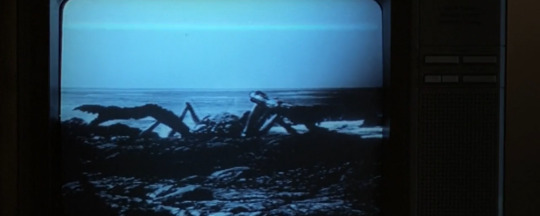
horror movies in horror movies (part 3)
the golem (1920) in ti piace hitchcock? (2005) the toxic avenger (1984) in slither (2006) black sabbath (1963) in the babadook (2014) the house on haunted hill (1959) in terrifier 2 (2022) the brain that wouldn't die (1962) in the unheard (2022) night of the living dead (1968) in all hallow's eve (2013) the tingler (1959) in the black phone (2022) the forgotten (1973) in house (1985) nosferatu (1922) in scream 2 (1997) frankenstein (1931) in scream (1996) the beast from 20,000 fathoms (1953) in gremlins 2 (1990) the birds (1963) in my soul to take (2010) the funhouse (1981) in halloween kills (2021) attack of the crab monsters (1957) in chopping mall (1986)
#horror#horror movies#the golen#ti piace hitchcock#the toxic avenger#slither#black sabbath#the babadook#the house on haunted hill#terrifier 2#the brain that wouldn't die#the unheard#night of the living dead#all hallow's eve#the tingler#the black phone#the forgotten#house#nosferatu#scream 2#frankenstein#scream#the beast from 20000 fathoms#gremlins 2#the birds#my soul to take#horroredit#filmedit#moviesedit#cinema
374 notes
·
View notes
Text

HUNTER KILLER
Essex class carrier USS Princeton (CVS-37) after conversion to an antisubmarine carrier. She did not receive the SCB 27A upgrade but she had her tripod mast replaced with a pole mast, as seen here, in Jan 1957 and in March 1959 was redesignated (LPH-5). This photo was taken in that period and you can see Point Loma (San Diego) in the background.
A Grumman S2F Tracker is on the flight deck with a Grumman Avenger next to the island.
93 notes
·
View notes
Text

Donald Sutherland
Commanding and versatile actor known for his roles in MAS*H, Don’t Look Now and The Hunger Games
Donald Sutherland, who has died aged 88, brought his disturbing and unconventional presence to bear in scores of films after his breakthrough role of Hawkeye Pierce, the army surgeon in Robert Altman’s M*A*S*H (1970), one of the key American films of its period. It marked Sutherland out as an iconoclastic figure of the 60s generation, but he matured into an actor who made a speciality of portraying taciturn, self-doubting characters. This was best illustrated in his portrayal of the tormented parent of a drowned girl, seeking solace in a wintry Venice, in Nicolas Roeg’s Don’t Look Now (1973), and of the weak, nervous, concerned father of a guilt-ridden teenage boy (Timothy Hutton) in Robert Redford’s Ordinary People (1980).
Although Sutherland appeared in the statutory number of stinkers that are many a film actor’s lot, he was always watchable. His career resembled a man walking a tightrope between undemanding parts in potboilers and those in which he was able to take risks, such as the title role in Federico Fellini’s Casanova (1976).
Curiously, it was Sutherland’s ears that first got him noticed, in Robert Aldrich’s The Dirty Dozen (1967). During the shoot, according to Sutherland, “Clint Walker sticks up his hand and says, ‘Mr Aldrich, as a representative of the Native American people, I don’t think it’s appropriate to do this stupid scene where I have to pretend to be a general.’ Aldrich turns and points to me and says, ‘You with the big ears. You do it’ … It changed my life.” In other words, it led to M*A*S*H and stardom.
Sutherland and his M*A*S*H co-star Elliott Gould tried to get Altman fired from the film because they did not think the director knew what he was doing due to his unorthodox methods. In the early days, Sutherland was known to have confrontations with his directors. “What I was trying to do all the time was to impose my thinking,” he remarked some years later. “Now I contribute. I offer. I don’t put my foot down.”
Sutherland, who was born in Saint John, New Brunswick, Canada, was a sickly child who battled rheumatic fever, hepatitis and polio. He spent most of his teenage years in Nova Scotia where his father, Frederick, ran a local gas, electricity and bus company; his mother, Dorothy (nee McNichol), was a maths teacher. He attended Bridgewater high school, then graduated from Victoria College, part of the University of Toronto, with a double major in engineering and drama. As a result of a highly praised performance in a college production of James Thurber’s and Elliott Nugent’s The Male Animal, he dropped the idea of becoming an engineer and decided to pursue acting.
With this in mind, he left Canada for the UK in 1957 to study at Lamda (the London Academy of Music and Dramatic Art), where he was considered too tall and ungainly to get anywhere. However, he gained a year’s work as a stage actor with the Perth repertory company, and appeared in TV series such as The Saint and The Avengers. He was Fortinbras in a 1964 BBC production of Hamlet, shot at Elsinore castle and starring Christopher Plummer. He also appeared at the Criterion theatre in the West End in The Gimmick in 1962.
In 1959 he married Lois Hardwick; they divorced in 1966. Then he married the film producer Shirley Douglas, with whom he had twins, Kiefer and Rachel; they divorced in 1971. Kiefer, who grew up to become a celebrated actor, was named after the producer-writer Warren Kiefer, who put Sutherland in an Italian-made Gothic horror film, The Castle of the Living Dead (1964). Christopher Lee played a necrophile count, while Sutherland doubled as a dim-witted police sergeant and, in drag and heavy makeup, as a witch.
In an earlier era, the gawky Sutherland might not have achieved the stardom that followed the anarchic M*A*S*H, but Hollywood at the time was open for stars with unconventional looks, and Sutherland was much in demand for eccentric roles throughout the 70s.
He was impressive as a moviemaker with “director’s block” in Paul Mazursky’s messy but interesting Alex in Wonderland (1970), which contains a prescient dream sequence in which his titular character meets Fellini. In the same year, Sutherland played a Catholic priest and the object of Geneviève Bujold’s erotic gaze in Act of the Heart; he was the appropriately named Sergeant Oddball, an anachronistic hippy tank commander, in the second world war action-comedy Kelly’s Heroes; and he and Gene Wilder were two pairs of twins in 18th-century France in the broad comedy Start the Revolution Without Me.
Sutherland was at his most laconic, sometimes verging on the soporific, in the title role of Alan J Pakula’s Klute (1971), as a voyeuristic ex-policeman investigating the disappearance of a friend and getting deeply involved with a prostitute, played by Jane Fonda.
Sutherland and Fonda were teamed up again as a couple of misfits in the caper comedy Steelyard Blues (1973). It initially had a limited distribution due mainly to their participation together in the anti-Vietnam war troop show FTA (Fuck the Army), which Sutherland co-directed, co-scripted and co-produced.
Sutherland always made his political views known, although they surfaced only occasionally in his films. In among the many mainstream comedies and thrillers was Roeg’s supernatural drama Don’t Look Now, in which Sutherland and Julie Christie are superb as a couple grieving their dead daughter. Despite the dark subject matter, the film was notable for containing “one of the sexiest love scenes in film history”, according to Scott Tobias in the Guardian, the frank depiction of their love-making coming “like a desert flower poking through concrete”. The actor so admired Roeg that he named another son after him, one of his three sons with the French-Canadian actor Francine Racette, whom he married in 1972.
John Schlesinger’s rambling version of The Day of the Locust (1975) saw Sutherland as a sexually repressed character – called Homer Simpson – who tramples a woman to death in an act of uncontrolled rage. Perhaps Bernardo Bertolucci had that in mind when he cast Sutherland in 1900 (Novecento, 1976), in which he is a broadly caricatured fascist thug who shows his sadism by smashing a cat’s head against a post and bashing a young boy’s brains out. “And I turned down Deliverance and Straw Dogs because of the violence!” Sutherland recalled.
In Fellini’s Casanova, the second of his two bizarre Italian excursions in 1976, Sutherland coldly calculates seduction under his heavily made-up features. The performance, as remarkably stylised as it is, still reveals the suffering soul within the sex machine.
In 1978 he appeared in Claude Chabrol’s Blood Relatives, a made-in-Canada murder mystery with Sutherland playing a Montreal cop investigating the murder of a young woman. More commercial was The Eagle Has Landed (1976), with Sutherland, attempting an Irish accent, as an IRA member supporting the Germans during the second world war, and as a chilling Nazi in Eye of the Needle (1981). Meanwhile, he was the hero of Invasion of the Body Snatchers (1978), who resists the insidious alien menace until the film’s devastating final shot.
In 1981 Sutherland returned to the stage, as Humbert Humbert in a highly anticipated version of Vladimir Nabokov’s Lolita, adapted by Edward Albee. It turned out to be a huge flop, running only 12 performances on Broadway. Both Sutherland and Albee played the blame game. “The second act is flawed,” Sutherland said. “Albee was supposed to have rethought it, but he never did.” Albee told reporters that he had scuttled some of his best scenes because they were “too difficult” for Sutherland because “he hasn’t been on stage for 17 years”.
Continuing his film career, Sutherland played a complex and sadistic British officer in Hugh Hudson’s Revolution (1985), and in A Dry White Season (1989) he took the role of an Afrikaner schoolteacher beginning to understand the brutal realities of apartheid. In Oliver Stone’s JFK (1991), he held the screen with an extended monologue as he spilled the conspiracy beans to Kevin Costner’s district attorney hero Jim Garrison.
After having made contact with young audiences in the 70s with offbeat appearances in gross-out pictures The Kentucky Fried Movie (1977) and National Lampoon’s Animal House (1978), the latter as a pot-smoking professor, he was cast as an unconvincing bearded stranger in Buffy the Vampire Slayer (1992).
On a more adult level were Six Degrees of Separation (1993), in which he played an unfulfilled art dealer; A Time to Kill (1996), as an alcoholic, disbarred lawyer (alongside Kiefer); Without Limits (1998), as an enthusiastic athletics coach; and Space Cowboys (2000), as an elderly pilot. By this time, he was gradually moving into grey-haired character roles, one of the best being his amiable Mr Bennet in Pride and Prejudice (2005).
The Jane Austen novel was also featured in the television series Great Books (1993-2000), to which Sutherland lent his soothing voice as narrator. Other series in which he shone as quasi baddies were Commander in Chief (2005) – as the sexist Republican speaker of the house opposed to the new president (Geena Davis) – and Dirty Sexy Money (2007-09), in which he played a powerful patriarch of a wealthy family.
Sutherland continued to be active well into his 80s, his long grey hair and beard signifying sagacity, whether as a contract killer in The Mechanic, a Roman hero in The Eagle, a nutty retired poetry professor in Man on the Train (all 2011), or a quirky bounty hunter in the western Dawn Rider (2012), bringing more depth to the characters than they deserved. As President Coriolanus Snow, the autocratic ruler of the dystopian country of Panem in The Hunger Games (2012), Sutherland was discovered by a new generation; he went on to reprise the role in three further films in that franchise, beginning with The Hunger Games: Catching Fire (2013).
He played artists in two art-world thrillers by Italian directors: in Giuseppe Tornatore’s Deception, AKA The Best Offer (2013), he was a would-be painter helping to execute multimillion-dollar scams, while in Giuseppe Capotondi’s The Burnt Orange Heresy (2019) he was on the other side of the heist as a reclusive genius targeted by a wealthy and unscrupulous dealer (Mick Jagger).
Aside from James Gray’s science-fiction drama Ad Astra (also 2019), in which he co-starred with Brad Pitt, Sutherland’s best late work was all for television. In Danny Boyle’s mini-series Trust (2018), which covered the same real-life events as Ridley Scott’s All the Money in the World, he played J Paul Getty, the oil tycoon whose grandson is kidnapped; while in The Undoing (2020), he was the father of a psychologist (Nicole Kidman), reluctantly putting up bail when her husband (Hugh Grant) is arrested for murder.
For the latter role Sutherland was in the running for a Golden Globe, having already received an honorary Oscar in 2017.
He is survived by Francine and his children, Kiefer, Rachel, Rossif, Angus and Roeg, and by four grandchildren.
🔔 Donald McNichol Sutherland, actor; born 17 July 1935; died 20 June 2024
Daily inspiration. Discover more photos at Just for Books…?
53 notes
·
View notes
Text
THOUGHT OF THIS - BLACK BROTHERS HEADCANNON :p
Regulus knelt down opposite the grave, placing the photo he’d brought against the headstone.
SIRIUS ORION BLACK | 3rd November 1959 - 14th July 1965
The photo was of the two of them, before either of them joined Hogwarts. Before Sirius chose James Potter over him.
But Regulus still likes to visit Sirius, every now and then. To show, that even before he died, Regulus still loved him. Although Sirius didn’t back.
It’s been a year since his brothee died. No, he didn’t die. Sirius was murdered. By the person who calls herself their mother.
A year ago today, Sirius and their mother had argued. Regulus remembers every word from what he heard, standing on the landing. Hearing every word. They’d argued over Hogwarts - grades, behaviour, etc. Over Sirius’ friends and his views on the Dark Lord.
Sirius had always had a flair for the dramatic. Regulus should’ve known he’d test their mother too hard one day. But somehow he was hopeful Sirius would keep in line, to stay with Regulus. But no.
Walburga had pulled the arranged marriage out - it’d been a plan in thr making, to conform Sirius to The Noble and Most Ancient House of Black’s standards. Sirius came out to her (which Regulus was surprised she didn’t know already because it wasn’t like Sirius tried to hide it).
She’d hurt him, that wasn’t out of the ordinary. But Sirius had retaliated, punching her in the eye. Regulus’ memory goes a vit fuzzy there. Which is unusual since he has an eidetic memory. But he remembers Sirius bleeding. Alot. Like alot alot.
Regulus has no regrets except not helping his brother that day. Because Sirius had left the house, and died of blood loss a few roads away.
Regulus hadn’t seen the body - yes because he wasn’t allowed, but also because he couldn’t bring himself to after being the reason that Sirius might not have made it.
He saw a black dog limp past the road the night Sirius left, and he swears that it mayhe looked at him.
The Black family carried on as normal of course, because showing emotion was too human for them. Regulus had been moved to Beaubatens, because his mother insisted it was Hogwarts who turned Sirius into a blood traitor. It wasn’t horrendous, but it was more difficult without Barty, Evan, Dora and Dorcas.
The girls there were nice, and there was another closeted transgender there, Cole, who talked too much but Regulus didn’t mind him.
But the term ended and Regulus returned to Grimauld Place. Haunted by the empty presence of Sirius. So he left to the graveyard, to talk to his brother. “Sirius. Merlin, I don’t even know why I’m here. You’re dead. You can’t hear me. Mother and Father have lost their minds. Obsessed with joining the Dark Lord’s side. He’s a half-blood as well, you know? Idiot. You’d have a bloody field day making fun of Voldy for that.”
Regulus feels a tear fall from his chin, onto the dirt. “They want me to take the mark. Next year. I’m expecting me to obey. Like a performing seal or something. But I guess you’re lucky, you got out. They’ve started doing the things they did to you to me. Not as badly, you always had Mother on. Perhaps you’re not so lucky. Don’t worry, Sirius. I’ll avenge you or some shit.” He wipes his face with his sleeve.
Looking down at the headstone, Regulus resumes his one-sided conversation, “I miss you. You probably don’t miss me. But I do, the house and the holidays are too quiet without your constant yapping. Mother tried to take down your Gryffindor poster again yesterday, you must’ve used a permanent sticking charm or something because she can’t get it off for the life of her.” He scans the grave yard, and checks his watch. “It’s getting late, I might come back tomorrow. I’ll slip away. J'aime ton frère. Et je te verrai bientôt.“
•»—«•
Three years later
Regulus grabs the locket from the basin. Having just drunk a shit ton of some poison that Riddle left for whoever came looking. He’s parched. He’d read something about osmosis in a muggle biolgy textbook, but that doesn’t matter now.
He fumbles with his wand, “aguamente.” Nothing happens, the Dark Lord probably used a charm so one couldn’t drink. Regulus claps his hand around the shell, and practically crawls to the edge of the island. He dips it in the water.
A hand reaches out at him. It grabs his wrist, making his hand fall. Took him by surprise, so he doesn’t fully comprehend when Regulus is being dragged into the water by an inferi.
The note, written before he even entered the cave, is charmed to the bottom of the basin, along with a dequoy locket he’d made. “Kreacher. Give this,” he hands the lcoket to the house elf, “to Pandora Lovegood. Tell her to destory it. And share my notes from the loose floorboard under my bed with her. Please.”
Regulus had one thought before his slaughter. At least I’ll see Sirius again.
Little did Regulus know, Sirius was living in Godric’s Hollow with his new family. Unknowing of the moment that his little brother’s heart stopped beating.
26 notes
·
View notes
Note
I'm not sure if you answer questions like this, but I'm trying to get into Marvel, and I'd love to read more about "Cap’s Kooky Quartet" do you have any reading list recommendations of them?
I love Cap's Kooky Quartet so much, and I do give comic guides/recs upon request if I'm able to. This era may not have lasted long but it's my favorite.
For a quick overview of this era check out; marvelsilverage.
To see Cap's Kooky Quartet in animation they appear in one of the episodes of Marvel Super Heroes (1966) which you can see for free on the Internet Archive, it basically covers a few of their adventures.

Cap's Kooky Quartet Comic Reading Guide
The Avengers (1963) #16-19
Journey into Mystery (1953) #120
The Avengers (1963) #20
Fantastic Four (1961) Annual 3
The Avengers (1963) #21-22
Tales of Suspense (1959) #72
The Avengers (1963) #23-28
A few of these issues just have cameos but the bulk of their adventures are in Avengers. After issue 28 it's no longer a Quartet as more members join.
Avengers (2016) #3.1
As you read through comics you will often find little flashbacks to this era, especially when characters like Quicksilver rehash their backstories. This guide is meant to get you started but you can read on in The Avengers comics to see the character's journeys. There's a lot of resources for new comic readers. Also If you check Marvel Fandom Wiki and search for specific comic characters then you will find their full appearance list towards the bottom of each character page that you can use as a guide if you want to follow that character. That's the best way to get started reading because it helps you to narrow down which comics you want to start with and where they show up next. Hope this guide helps!
#caps kooky quartet#quicksilver#scarlet witch#hawkeye#captain america#imp answers#comic reading guide
12 notes
·
View notes
Text
Countdown to Halloween 2023, Ranked
43. Swamp Thing (1982)
42. Curse of Bigfoot (1975)
41. The Haunting (1999)
40. Orca (1977)
39. Teenagers Battle The Thing (1958)
38. The Beast (1975)
37. Don't Go in The House (1979)
36. Countess Dracula (1971)
35. Hillbillys in a Haunted House (1967)
34. Beware! The Blob (1972)
33. Alien Space Avenger (1989)
32. Baby Blood (1990)
31. Shriek of The Mutilated (1974)
30. The Mutations (1974)
29. Phase IV (1974)
28. Curse of The Faceless Man (1958)
27. The Sadist (1963)
26. Jennifer (1978)
25. The Wasp Woman (1959)
24. Noroi: The Curse (2005)
23. Girls Nite Out (1982)
22. The Monster of Piedras Blancas (1959)
21. The Cat and The Canary (1927)
20. Tell Your Children (Reefer Madness, 1936)
19. The Company of Wolves (1984)
18. It's Alive (1974)
17. The Wolf House (2018)
16. Michael Jackson's Halloween (2017)
15. The Girl Who Knew Too Much (1963)
14. The Omega Man (1971)
13. Gamera: Rebirth (2023)
12. Student Bodies (1981)
11. Night Caller From Outer Space (1965)
10. Inhumanoids (episodes 1 - 5, 1986)
9. Blind Woman's Curse (1970)
8. Maniac (1980)
7. The Child (1977)
6. Zombie 3 (1988)
5. Return of The Living Dead (1985)
4. Spider Baby (1967)
3. Basket Case (1982)
2. Messiah of Evil (1973)
Godzilla (1954)
Woof. Okay. This has been a mostly disappointing viewing experience.
Critical difference between this year's countdown and the past two is that now that I have stable employment, there is far less time to be watching horror films. I normally begin the countdown in September but we started in July of this year and still barely managed to crack 40, with my original goal being a full 100 this year. Timing. As such a lot of my plans and possible viewings were cut short and compared to last year specifically we fell back on a lot of "seen it already" at least for the top of the list.
This year's batch of viewings were largely blah, but a step up from the shitshow I put myself through last year (watching nearly every Texas Chainsaw sequel does things to a person). As such it'll be difficult to conjure up words for a decent chunk of these mostly because yes, these movies exist, I watched them, I would not recommend that you yourself watch them. That is all. If I write briefly on a given film that's not necessarily an indictment of its quality as there a decent number of these that I saw and enjoyed it's just their impact might be a bit fleeting. You will know which ones I actively disliked. I mostly just want to write about the top five or so but I will play fair.
Our grand loser this year is Swamp Thing, the DC Comics adaptation by Wes Craven. I watched this pretty much entirely because I finally got the Alan Moore Swamp Thing run in paperback this year after quite some time of having it on my to-buy list. Longtime Rachael/Ray/Ratchet fans may recall me reading it in early 2019 alongside [REDACTED]. Still one of the best Moore comics, and a second volume of Swamp Thing wouldn't have been possible without the success of this film. For context I did read the early Swampies by Len Wein and Bernie Wrightson and my general reaction to those was a'ight but there was definitely material for a serviceable film adaptation there. This is not that serviceable film adaptation. I'm not hung up on details like how Abigail has no connection to Arcane now despite being his niece in the comics, but this film is just kind of painful in how relatively unambitious it is which is saying something for Swamp Thing sword fighting another human mutation at the end of this. It's just silly and stupid and not scary or awe inspiring or anything, the Swamp Thing suit sucks, the action sucks, any sense of pathos is not there or gone, it stretches for 30 minutes too long like it's a padded TV pilot, the only highlight is being able to see Adrienne Barbeau's breasts. Fuck this it's a miserable experience to sit through. My mistake for watching a Wes Craven film that doesn't have "Scream" in the title.
Our next shitter is the two-for-one abomination that is Teenagers Battle The Thing (1958) and Curse of Bigfoot (1975); these are the same movie except Curse of Bigfoot has a 25 minute opening scene framing device that is bizarre given that "The Thing" of the original film is a Native American mummy of some sort unearthed by a group of white high school students. It's the rare personal pet project movie made for fun by some locals but the only highlights are the occasional kill scene, Curse of Bigfoot ranks lower just for making me sit through it longer. Blah.
Speedrunning through a bunch of these because theyre all varying degrees of bad and I don't want to spend any longer writing about these than you probably do reading about them: The Haunting is awful and I don't even super care for the original film so adding shitty CGI monsters and a moral lesson of "it's about family!" doesn't help. Orca is a shitty Jaws cash-in that's like a reverse Moby Dick where the sea animal hunts down the human, nice finale where the orca and shitty poacher guy are fighting it out in the Arctic but otherwise avoid. Don't Go in The House is a mysoginistic torture porn movie that really doesn't sell the "seemingly normal guy is a closet nutcase" thing even though movies made before and after have done it well (see Maniac several paragraphs below). The Beast is advertised as this really scandalous porno film but most of it is French aristocrats sitting around in stuffy rooms arguing about real estate. I think I only watched Countess Dracula for its inclusion in the "if this is her vibe I would fucking cum" meme and it's barely worth bringing up at all. Hillbillys in a Haunted House has an absolutely lovely Tennessee country soundtrack that I wish I could listen to without having to watch the actual movie which is devoid of both scares and laughs. Beware! The Blob gives off the feeling of sitting at a funeral for a family member that was just distant enough for you to be aware of them but not actually be upset but it's still a funeral so it's not like you're smiling, stick with the 1988 Blob film. Alien Space Avenger has some decent gore effects but that's all I can recall from it. Shriek of The Mutilated has one of the best titles for an otherwise uninspired yeti movie that has a needless third act twist about it being a cover for a cult and blah blah blah fuck you. Baby Blood has an alien mutant whatever crawl up a woman's vagina into her womb and she has to eat people to feed it and yeah I'm actually struggling to remember what happens here. The Mutations has a scene where a guy cuts into a tree and it bleeds, I think he's played by Donald Pleasance. Yeah, it's like Freaks except it plays to the freak show straight so you get to laugh at all the outcasts of society, no thank you.
Some odds and ends that I'd say are decent-to-pretty-good: Phase IV has some footage of ants and synth music. All you need is some footage of ants and synth music. Curse of The Faceless Man employs a rarely seen archetype of the living statue monster, it's cute. The Sadist is another starring vehicle for Arch Hall Jr., who was also the star of last Halloween's Eegah! (1962), though this film is a bold trendsetter for the 1960's with Hall being a unhinged killer holding people for ransom until they can fix his car and he can make a getaway. The film lives and dies by Hall's performance and it's mostly the latter until we get to an absolutely superb final act with him hunting down his remaining victims, it makes the whole film worth seeing. Jennifer is an oddball that plays out mostly like a character drama ("It wasn't my fault Daddy it was that stupid hillbilly bitch Jennifer") that suddenly remembers that it's supposed to be a cash-in of Carrie (1976) in the last 20 minutes and cue our titular character being able to summon and control snakes to send after her tormentors. Girls Nite Out is a plodding meandering slasher that's oddly hypnotizing considering so much of it takes place in pitch-black night and the killer is wearing a bear mascot costume with serrated knives hidden under the glove, not sure what fully to make of it. The Monster of Piedras Blancas is made up of leftover parts from the Gillman, Mole People, and Metaluna Mutant, but still manages to star in a decent enough film that gives a sense of what a series of monster attacks would do to a small seaside community. The Cat and The Canary is "cute" for lack of a better term being a horror comedy before the former genre had fully crystalized. Reefer Madness is horror adjacent more than anything but a hilariously good time about how the use of "marihuana" will drive today's youth into becoming crazed fiends and get involved in organized crime.
We can do this.
The Company of Wolves has an excellent story book like setting an atmosphere that you can't get in films nowadays and it's a shame that it's mostly remembered for its transformation sequences. it's Alive is the best Larry Cohen film by default of not sucking but it's still not "great", genius however for playing the concept of mutant newborn killer baby completely seriously without any sense of humor to the proceedings. The Girl Who Knew Too Much is almost a parody of giallo films which is interesting given those hadn't fully sprang up in 1963; absolute highlight is the main character being interviewed in bed by doctors and reporters and the like that yes she did see a murder and no she doesn't drink. I've always been fascinated and haunted by I Am Legend and while The Omega Man doesn't really capture the novel to a superb degree it's so beautifully shot that it lands high in the rankings for that alone. Night Caller From Outer Space is hilarious to me because of how it shifts halfway through from a Hammer-esque mystery about a meteorite with radioactive properties to a film about an alien that lures women in through a modeling advertisement. Blind Woman's Curse I've mentally confused with Irezumi for a while now (haha all 1960's Japanese genre films where woman have large animal tattoos on their backs are the saaame), and it's one I mostly watched for being directed by Teruo Ishii, but there's enough bloody yakuza fights and cats licking up blood for me to stick around; not the strongest Meiko Kaiji vehicle compared to Female Prisoner Scorpion or Lady Snowblood. Maniac I find mostly interesting as a precursor to American Psycho (2000) but also it's probably the only serious film to successfully pull off it's ending trope (which I will not spoil here). The Child is an absolutely lovely 1970's only-a-dozen-people-made-this-and-not-much-more-watched-it horror that oozes atmosphere, I could watch stuff like this all day. Aaand Zombie 3 is far and away the best film that Lucio Fulci has been involved with that I've ever seen. I love random scenes and set pieces of ghouls just massacring people that are shit out out of luck.
Okay, now for the ones I actually want to write about.
The Wasp Woman is one that sticks in my head way more than any other random monster movie that Roger Corman directed in the latw 1950's. I've said on here and Letterboxd that it could have served as a standard pop-feminist piece about how the cosmetology industry is built on misogyny and invariably a monster is accidentally created because of that, but this most recent viewing has made me sort of "get it" because that might be what the film is going for considering Susan Cabot's performance leads me to believe that she is aware that she is becoming a homicidal wasp monster but views it as a tragic means to an end where she still has the ability to have a new advertising campaign with her as the star. Tragic. This is why you don't wear make up.
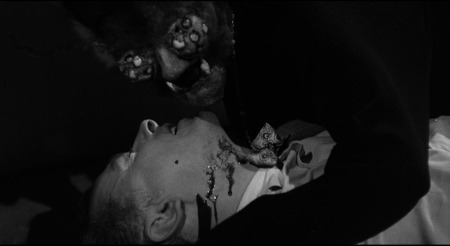
Both Noroi: The Curse and The Wolf House are ones I didn't care for whatsoever but I put them in places on the ranking that I thought were fair given that people should probably watch them regardless of my personal thoughts. Noroi's format didn't really lend itself to the escalation of tension and reveal of information that the plot demanded and I found myself thinking it meanders quite a bit. The Wolf House was an odd one where everything that was happening onscreen bounced off of me mostly because I felt intimately aware that I was watching a movie, that someone had made something and that I was now being shown it. Blah. People like these so don't let me stop you.
Our animated offerings this year...
Michael Jackson's Halloween more than anything feels like an unlicensed creation that later had an English fan dub commissioned, not something that actually aired on CBS twice. Any laughs that I found in this thing were the unintentional type as we open up with Bubbles talking and being Jackson's chauffeur; you know exactly what you're getting into. Very little of the plot is explained but I'm assuming Jackson (who has no lines given this was made posthumously) orchestrates a dark fantasy adventure to hook two...teenagers? People in their late 20's? And convince them to follow their dreams of performing instead of working a deadend dayjob. I'm not sure who the actual audience for this was given it feels like so much of it was made for children but I will say anything that has this much of Michael Jackson's music in it can't be all bad, though I'm not sure why they didn't largely stick with tracks from the album Thriller (in the contention for best album ever, I don't care).

Gamera: Rebirth is one I feel like I'm on the outside on compared to most other tokusatsu fans because I didn't really *love* to a serious degree even though, yes, Gamera is finally back. The first three episodes are mostly just kind of a slog for me with the backhalf not doing enough to retroactively make me think highly of it, though giving off End of Evangelion vibes may make me consider that a second viewing must be in order down the line. Rebirth's strongest attribute is that it feels like it takes into consideration and influence from every prior era of Gamera, no stone is left unturned, and it's a marked contrast from how every recent Godzilla property only captures a single facet of their respective character. But that also creates unique issues like how a lot of criticism of ongoing US military presence in Japan is undercut so there can be a white kid in the main cast (because white children were always present in half of the Showa series) or having the ancient civilization that genetically engineered the kaiju now being malicious and actively sacrificing children as a means of reshaping the world gives me vaguely anti-semitic tones, I don't know, Gamera is still here, I guess.

"I was just a little twerp who liked Scooby-Doo and Smurfs, now I was viewing Cthulhu mutants ruin the Earth."
Everyday that we have Inhumanoids is a gift. Inhumanoids is another Hasbro/Sunbow production like G. I. Joe, Transformers, or Jem and The Holograms, and it is truly tragic that it never got anywhere near that level of attention compared to its siblings. The fact that a 1980's action figure tie-in cartoon is named for its antagonists is only the start; the series follows a small paramilitary outfit of scientists named Earth Core that are tasked with more or less saving the world alongside the Mutores, elemental beings, when the Inhumanoids, eldritch abominations, are unleashed. The degree of world-building beyond your typical "good guys vs. bad guys" affair is astounding with villainous humans and virtuous monsters abounding, but Inhumanoids is mostly magical and remembered for saying fuck all to any type of broadcast standards. Seeing giant monsters destroy cities, undead armies, and spelunking deep into the Earth (where nightmares begin...) are just standard fair here, as are witnessing the actual Inhumanoids such as Metlar (basically the devil) or D'Compose (giant undead entity that can zombify people by touching them and uses his ribcage like a jail cell) in action. The first five episodes here are the pilot movie of sorts for the series which only lasted thirteen overall, and they get more grissly from here on out, but maybe it's best that Inhumanoids is the short lived cartoon and no the cartoon that went soft as early as its second season. I will never not love this show, to this day it's one of my favorite animated series from any decade, much less the 1980's.
Back to our regularly scheduled live-action programming...
Student Bodies is a fascinating film for a myriad of reasons the first of which is that there were somehow enough slasher films by 1981 for there to be a comedy poking fun at all the already established genre-cliches. It's essentially Scary Movie (2000) a full 20 years ahead of the curve only actually funny in spite of the subject matter frequently being as juvenile and prejudiced; but it also reminds me quite a bit of Scream (1996) with stuff like two killers working together. All I know is I was in for a decent time when the film opens with three identical shots of a house just with different framing text: "HALLOWEEN," "FRIDAY THE 13TH," "JAMIE LEE CURTIS' BIRTHDAY" and then the killer, The Breather, calls the opening kill girl doing nothing but breathing heavily, she hangs up, he calls back with "I SAID [heavy breathing]."
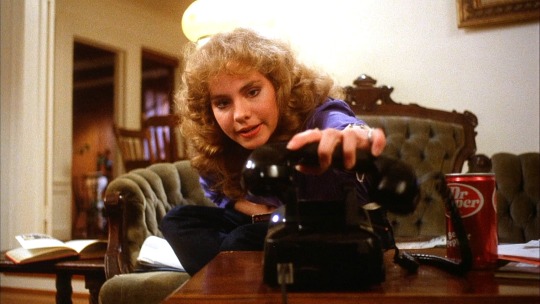
Return of The Living Dead is one of those films that should have destroyed the any artifically-imposed boundaries between "high" and "low" art. Every aspect of this film is brilliantly made, it just so happens to be made for stuff like Scooby-Doo music overlaid on top of thunderstorms over graveyards where one female character is stripping to the concept of dying. Media involving ghouls is incredibly oversaturated, and this was still the case in the 1980's where a film like this had to redefine the rules to make it so killing ghouls was basically a non-option. It only recently struck me on this viewing that that's the whole purpose of removing virtually all weaknesses they have, to keep the characters as the nail instead of the hammer. Compared to the Romero films, there's never a point where anyone is in control of the situation, it just escalates further and further until there is literally no way out. Taking that into consideration, there's no way this film couldn't have been a comedy that frames people getting swarmed and eaten by ghouls as hilarious.
The soundtrack and the faux-punk sensibilities lend this a daft feeling of "you shouldn't be watching this" in spite of it not being one of the MOST gory horror films of the 1980's. I still don't get how this never broke into the mainstream. I mean somehow people know that ghouls (in this film) speak and only eat brains but I can't go down to Target and get a Tarman action figure like I can one of Michael Myers. As such Return of The Living Dead remains a criminally overlooked film regardless of its subject matter. It's made me laugh and cringe and feel disgusted and revolt at the concept at dying but mostly it's made me feel a delicious sense of joy at seeing corpses rise out of the ground to the tune of "Do you wanna party? IT'S PARTY TIIIME!" Some of you need to sit in the corner and think about your life choices for making stupid shit like Re-Animator (1985) or fucking Shaun of The Dead (2004) more popular than this, fuck you.
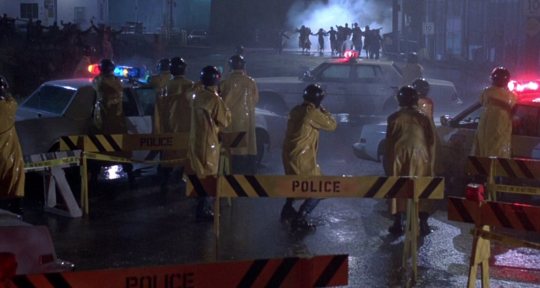
The act of watching Spider Baby is like discovering the missing link. For as much as 1960 gave us an explosion of horror (Eyes Without a Face, The Ship of Monsters, Psycho, Jigoku, Black Sunday, etc.) and Night of The Living Dead (1968) reins as the perennial transition point of the genre, Spider Baby is the road by which we go from The Cat and The Canary and The Old Dark House to the likes of The Texas Chainsaw Massacre and Eraserhead, it's magical finding an essential piece of a genre you love so much. Both the former and latter points of comparison are apt as a family of now only children [and their butler] suffering from Poe-esque hereditary illness have their condemned house set upon by distant relatives and everything slowly unravels.
Lon Chaney Jr. is an actor who for the longest time I felt never got a proper chance to shine wherein the last 25 years or so of his career was spent playing as side character actor in independent films. Spider Baby is his crowning achievement. Seeing him smile through almost tears on several occasions as he has to play bridge between worlds of sanity and madness and lie to everyone that he has some sense of control over the situation is brilliant in ways I always knew he was capable of but had never seen before this point. Bravo.
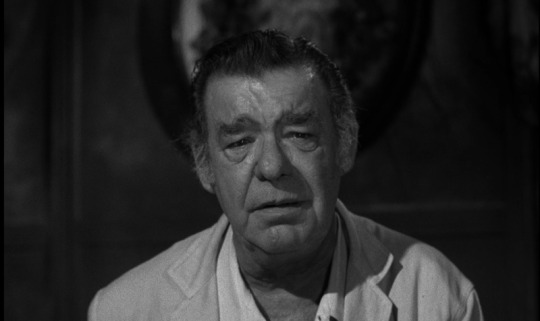
I will never not love Basket Case with everything I've got. This is the epitome of 1980's horror and my clear pick for best of the decade. It has everything from being a grungy putrid grindhouse spectacle to being an intimate character drama to everything presented through a wry ironic lense where you can't tell if any "bad" performances are all done on purpose. Between this, Brain Damage (1988), and Frankenhooker (1990), there is literally absolutely no reason why Frank Henenlotter shouldn't be more popular than Stuart Gordon, Brian Yuzna, and Lloyd Kaufman *combined*. It's tragic that the world of cinema being enclosed and captured by studios again in the late 1980's prevented us from getting more from him, but realistically could we ask anymore than what we already got from Basket Case? I could watch this every day and never grow tired of it. I will never stop making more and more people watch this.
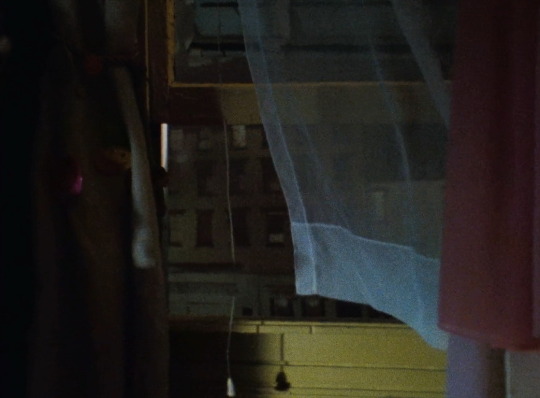
If Basket Case is the apex of 1980's horror, then Messiah of Evil is the same for 1970's horror. This is one of the most efficient horror films ever made in how not a single frame is wasted, the opening scene is literally a guy running from unseen force, seeking refuge, getting his throat slit, cue title card with synth music that then leads us to a sunburnt hallway as our narrator descends into acceptance of complete lack of control of the situation. Every night shot in this film must be 50 - 75% completely black with whatever headlight or store front there is just making the scenery look like a dollhouse that our characters are trapped inside. There's so many shots of people running away or walking down streets that make them look tiny as the camera is so far.
Every scene is an exercise in building up dread. There's no point where the film relents, something awful is not only coming, it's already here and there's nothing anyone can do. What I love particularly is that the mystery being laid out doesn't offer any answers because there's another mystery on top of what our characters find out only too late. Layers upon layers of dread that even the titular Messiah of Evil isn't the center of. The world is a cruel fucking place where this film languishes in obscurity whilst shit like The Exorcist enjoys mainstream attention. A lot of my taste amounts to "why isn't this thing I like more popular" and cases like Messiah of Evil vindicate me.
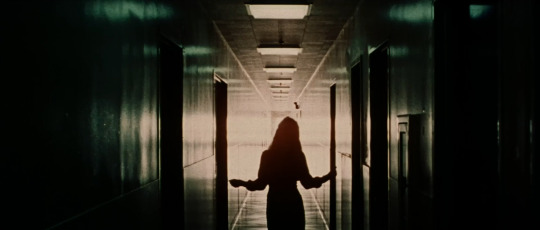
"Godzilla is the son of the atomic bomb. He is a nightmare created out of the darkness of the human soul. He is the sacred beast of the apocalypse." - Tomoyuki Tanaka
Generally a yearly trend is that a #1 pick for Halloween is self-evident to me and this year it was Basket Case for all of 30 seconds until I picked Godzilla back up.
There's something to be said how Godzilla isn't quite a horror monster? Terrifying but not necessarily creepy, but what power do things that go bump in the night have against the destruction of everything you know? Everytime I watch Godzilla is like the very first time, when flashing lights out at sea destroy fishing ships I have no idea what happened, or at least any much of a clue as anyone in film does when we're told that the entire ocean exploded.
Godzilla is a reptile, but lacks scales and its entire body is coated in keloid scars. In 1954 Godzilla must have been the largest monster every committed to film, trains are derailed from running against its ankle and bell and radio towers are throttled for being a sensory inconvenience. Godzilla's first on-screen appearance on Odo Island is obscured by a hurricane but the impression is clear; you can't fight Godzilla in the same way you can't fight a natural disaster. When Tokyo is reduced to complete ruin amidst a sea of flames, it's an onslaught of destruction never before seen in a film of this genre. Survivors being afflicted with radiation poisoning shows that Godzilla will claim victims long after being driven back to sea.
There's a sheer apocalyptic dread to all of this sensed by all the characters. Love tries to exist on the edge of annihilation. There's nothing that can be done but persevere and maybe hope tomorrow will be better. A scene that always strikes me is when Serizawa is adamant about not using the Oxygen Destroyer until forcibly confronted with the results of one night of Godzilla making landfall in Japan. The absolute pain felt by everyone in the finale starts here, things couldn't play out any differently as the "scientist of the century" can't join in and celebrate his victory.
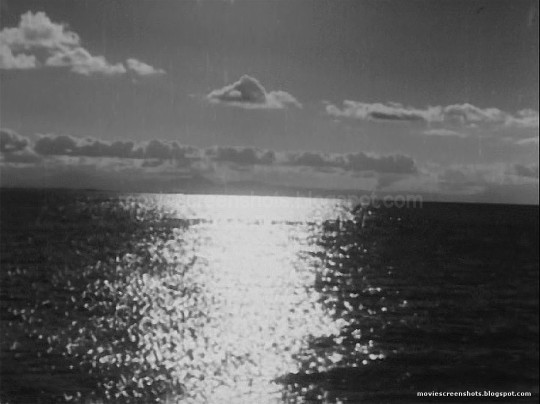
Godzilla is a rare perfect film. I will never tire of it.
26 notes
·
View notes
Text
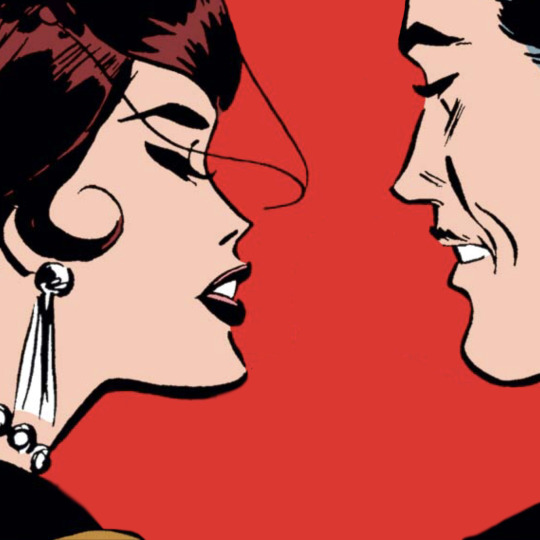
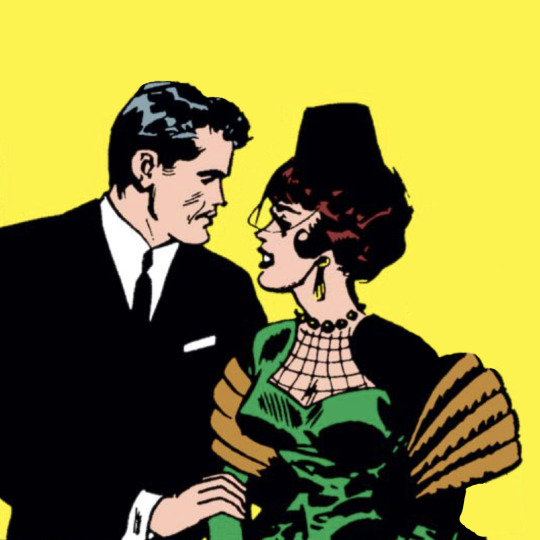
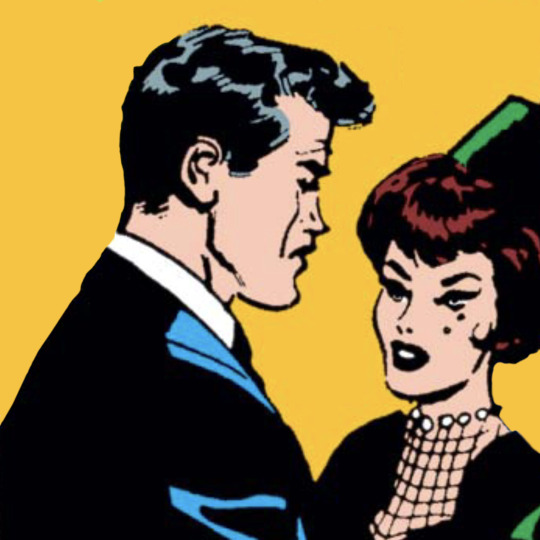

Natasha Romanoff & Tony Stark
Tales of Suspense (1959) #52
#marvel#avengers#marveledit#comicedit#tonystarkedit#ironmanedit#natasharomanoffedit#blackwidowedit#ironwidow#tony stark#iron man#natasha romanoff#black widow#takes of suspense (1959)#616#larry lieber#don heck#marvel comics#avengerscompoundedit
152 notes
·
View notes
Text
❤️ MOVIE TAGS ❤️
A
🤍 a bear named winnie (2004) 🤍 a dangerous method (2011) 🤍 a fistful of dollars (1964) 🤍 a most violent year (2014) 🤍 a room with a view (1985) 🤍 a royal affair (2012) 🤍 a streetcar named desire (1951) 🤍 a woman is a woman (1961) 🤍 an education (2009) 🤍 agora (2009) 🤍 all about eve (1950) 🤍 amadeus (1984) 🤍 and god created woman (1956) 🤍 angel (2007) 🤍 anna karenina (1948) 🤍 armageddon time (2022) 🤍 the artist (2011) 🤍 ashes and diamonds (1958) 🤍 atonement (2007)
B
🤍 the banshees of inisherin (2022) 🤍 barefoot in the park (1967) 🤍 the beguiled (2017) 🤍 belle (2013) 🤍 the big sleep (1946) 🤍 the bikeriders (2023) 🤍 the birds (1963) 🤍 bonnie and clyde (1967) 🤍 bram stoker’s dracula (1992) 🤍 breakfast at tiffany’s (1961) 🤍 brokeback mountain (2005) 🤍 brooklyn (2015) 🤍 bugsy (1991) 🤍 butch cassidy and the sundance kid (1969)
C
🤍 cabaret (1972) 🤍 captain america: the first avenger (2011) 🤍 carnival of souls (1962) 🤍 carol (2015) 🤍 casablanca (1942) 🤍 casino (1995) 🤍 cat on a hot tin roof (1958) 🤍 chicago (2002) 🤍 cléo de 5 à 7 (1962) 🤍 cleopatra (1963) 🤍 cria cuervos (1976) 🤍 crimson peak (2015)
D
🤍 daisies (1966) 🤍 dangerous liaisons (1988) 🤍 the danish girl (2015) 🤍 dead poets society (1989) 🤍 the debt (2010) 🤍 dirty dancing (1987) 🤍 don’t bother to knock (1952) 🤍 don’t worry darling (2022) 🤍 dracula (1931) 🤍 the duchess (2008) 🤍 dunkirk (2017)
E
🤍 east of eden (1955) 🤍 the edge of love (2008) 🤍 eileen (2023) 🤍 elizabeth (1998) 🤍 elizabeth: the golden age (2007) 🤍 elvis (2022) 🤍 emma (2020) 🤍 the end of the affair (1999) 🤍 the english patient (1996) 🤍 enola holmes (2020) 🤍 the eyes of tammy faye (2021)
F
🤍 fanny and alexander (1982) 🤍 the favourite (2018) 🤍 for a few dollars more (1965) 🤍 funny girl (1968)
G
🤍 gentlemen prefer blondes (1953) 🤍 giant (1956) 🤍 gilda (1946) 🤍 the girl on a motorcycle (1968) 🤍 gladiator (2000) 🤍 the godfather (1972) 🤍 the godfather: part ii (1974) 🤍 gone with the wind (1939) 🤍 the good, the bad and the ugly (1966) 🤍 goodfellas (1990) 🤍 the graduate (1967) 🤍 the grand budapest hotel (2014) 🤍 grand hotel (1932) 🤍 grease (1978) 🤍 the great gatsby (1974) 🤍 the great gatsby (2013) 🤍 guess who’s coming to dinner (1967)
H
🤍 the help (2011) 🤍 high noon (1952) 🤍 hiroshima mon amour (1959) 🤍 how to marry a millionaire (1953) 🤍 how to steal a million (1966)
I
🤍 ida (2013) 🤍 il gattopardo (1963) 🤍 the immigrant (2013) 🤍 in secret (2013) 🤍 inglorious basterds (2009) 🤍 it happened one night (1934)
J
🤍 jane eyre (2011)
K
🤍 the king (2019) 🤍 knife in the water (1962)
L
🤍 la dolce vita (1960) 🤍 la notte (1961) 🤍 la strada (1954) 🤍 ladies in lavender (2004) 🤍 lady chatterley’s lover (2015) 🤍 lady macbeth (2016) 🤍 the lady from shanghai (1947) 🤍 the last duel (2021) 🤍 legend (2015) 🤍 les misérables (2012) 🤍 the light between oceans (2016) 🤍 little women (2019) 🤍 the lover (1922) 🤍 the love witch (2016) 🤍 l’avventura (1960) 🤍 l’eclisse (1962)
M
🤍 macbeth (2015) 🤍 malèna (2000) 🤍 man with a movie camera (1929) 🤍 marie antoinette (2006) 🤍 mary, queen of scots (2018) 🤍 the master (2012) 🤍 meshes of the afternoon (1943) 🤍 miller’s crossing (1991) 🤍 the mirror (1975) 🤍 the misfits (1961) 🤍 moulin rouge! (2001) 🤍 the mummy (1999) 🤍 my fair lady (1964)
N
🤍 ninotchka (1939) 🤍 north by northwest (1959) 🤍 the northman (2022) 🤍 nosferatu the vampyre (1979)
O
🤍 once upon a time in america (1984) 🤍 once upon a time... in hollywood (2019) 🤍 once upon a time in the west (1968) 🤍 operation finale (2018) 🤍 the other boleyn girl (2008) 🤍 outlaw king (2018)
P
🤍 the pale blue eye (2022) 🤍 persona (1966) 🤍 phantom thread (2017) 🤍 the pianist (2002) 🤍 picnic at hanging rock (1975) 🤍 pride & prejudice (2005) 🤍 the prince and the showgirl (1957) 🤍 priscilla (2023) 🤍 the promise (2016) 🤍 psycho (1960) 🤍 the public enemy (1931) 🤍 purple noon (1960)
R
🤍 raging bull (1980) 🤍 rebel without a cause (1955) 🤍 rear window (1954) 🤍 repulsion (1965) 🤍 river of no return (1954) 🤍 the roaring twenties (1939) 🤍 rocco and his brothers (1960) 🤍 roman holiday (1953) 🤍 rosemary’s baby (1968) 🤍 rush (2013)
S
🤍 scarface (1932) 🤍 scarface (1983) 🤍 sense and sensibility (1995) 🤍 the seven year itch (1955) 🤍 the seventh seal (1957) 🤍 singin’ in the rain (1952) 🤍 sissi (1955) [trilogy] 🤍 slow west (2015) 🤍 some like it hot (1959) 🤍 the sound of music (1965) 🤍 splendor in the grass (1961) 🤍 the sting (1973) 🤍 stoker (2013) 🤍 summerland (2020) 🤍 sunset boulevard (1950) 🤍 sweet bird of youth (1962) 🤍 the swimming pool (1969)
T
🤍 their finest (2016) 🤍 the third man (1949) 🤍 this property is condemned (1966) 🤍 titanic (1997) 🤍 to catch a thief (1955) 🤍 to kill a mockingbird (1962) 🤍 tokyo story (1953) 🤍 the two faces of january (2014)
V
🤍 vertigo (1958) 🤍 vita & virginia (2018)
W
🤍 walk the line (2005) 🤍 waterloo bridge (1940) 🤍 west side story (1961) 🤍 white noise (2022) 🤍 who’s afraid of virginia woolf? (1966) 🤍 the wild one (1953) 🤍 wild strawberries (1957) 🤍 woman walks ahead (2017) 🤍 the wonder (2022) 🤍 wuthering heights (1992)
Z
🤍 the zookeeper’s wife (2017)
35 notes
·
View notes
Text
In the part about her origin in the Black Widow backstory flashbacks in The Amazing Spider-Man (1963) #86, published in April 1970, it’s portrayed that the life of Natasha’s husband was threatened if she didn’t succeed in her mission against Iron Man.

But in her actual first appearance in the Iron Man story in Tales of Suspense (1959) #52, published in January 1964, there’s no mention of someone close to her being threatened, only her being frightened for her own well-being at the end for failing.


The first portrayal of someone close to Natasha being threatened in order to made her cooperate with the Soviet Union is with her parents in the Iron Man story in Tale of Suspense (1959) #64, published in January 1965, though Natasha will later be portrayed as an orphan.


And Natasha is first revealed to have ever been married in The Avengers (1963) #43. And then in The Avengers (1963) #44, published in July 1967, she explains that she believed her husband was dead when she became the Black Widow.


3 notes
·
View notes
Note
I do appreciate that the Barbie movie appears to be mostly aimed at teenagers + adults though.
Obviously a lot of kids will see it, that's who Barbie as a brand is aimed at, but the PG-13 rating is nice in that it will appeal to the generation that primarily played with barbies. I'm sure plenty still do, but it's not quite the cult following it used to have as most of those people are now late teens/adult age. They could have just made a live action Barbie dream house rated E for everyone movie and chose not to.
As an adult, I'm stoked to see it. 🤷🏻♀️ I know it's just to make money and sell toys, propaganda, etc but it really is getting me hyped to see a hyper femme silly little movie a la Legally Blonde again.
Barbie has been a popular toy since 1959- the majority of people by definition who grew up playing with Barbies are well out of late teen/early adult age. Appealing to the older demographic while still having available movies for the younger demographic is really nothing new to capitalism- the MCU exists but so does the Avengers cartoon.
My point is not "Barbie movie capitalism bad", it's "those who are saying that are missing the point that most of these recent movie releases yes even the ones you like are doing literally exactly the same thing". There's roughly a million Lego movies, you think those aren't to sell toys????
28 notes
·
View notes